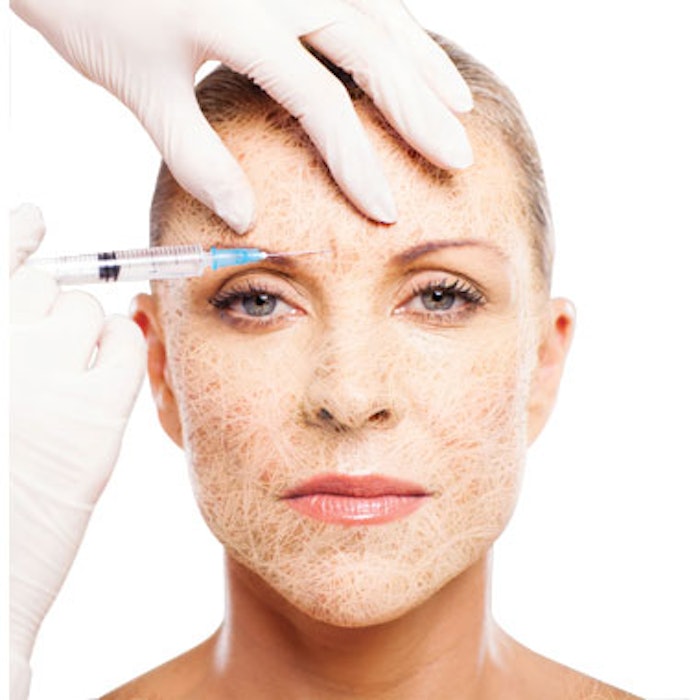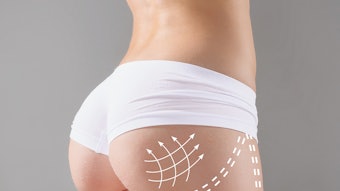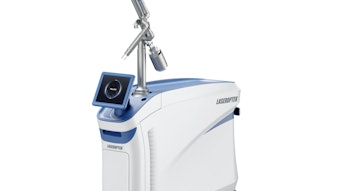
The 2015 International Society of Aesthetic Plastic Surgery (ISAPS) Global Procedural Survey revealed that botulinum toxin injections and hyaluronic acid (HA) dermal fillers are the two most popular nonsurgical procedures, with about 4.6 million toxin and 2.8 million filler treatments performed worldwide. The survey results also showed that HA filler popularity is on the rise, as that number represents a 6.5% increase over the previous year.
Regardless of your experience and training, if you perform a high number of injectable aesthetic treatments, you will encounter an adverse event (AE). When these complications occur, time is of the essence, so staff members, providers and patients must be trained to recognize early warning signs and respond quickly.
For starters, providers should always make sure they are using toxins and fillers that are approved by the U.S. Food and Drug Administration (FDA). Though physicians should know by now not to use research-grade injectables, it’s still worth noting, says Stephen Prendiville, MD, medical director of Prendiville Facial Plastic Surgery in Fort Meyers, Florida. “If a research-grade botulinum toxin or filler is used, you don’t know how many units are being delivered, and the results will be very unpredictable and potentially very unsafe,” he says, referring to a 2004 incident in which a physician used a research-grade toxin on himself and his friends, and they had to be hospitalized.
Ensuring a sterile environment is key to avoiding biofilm and mycobacterial infections. “Biofilm, which may occur when makeup or some other foreign body gets physically injected with the product, will lead to either granuloma formation or abscesses,” says Shino Bay Aguilera, DO, cofounder of Shino Bay Cosmetic Dermatology, Plastic Surgery & Laser Institute in Fort Lauderdale, Florida. “Mycobacteria is frequently found in surgical places—it could be in tap water or in dilution products that have expired and are therefore no longer sterile.”
This can be avoided by practicing good aseptic techniques and ensuring each patient’s skin is clean. At Shino Bay Cosmetic Dermatology, patients are prepped with ChloraPrep (chlorhexidine gluconate).
Some patients may develop an allergic reaction to the numbing agent used. “A contact dermatitis reaction can sometimes throw you off, but luckily the pattern will give you a good clue: The skin will be very angry and red wherever you put the numbing agent,” says Dr. Aguilera. “I’ll remove the numbing medication and give the patient a topical corticosteroid to treat the reaction; and I will delay treatment if the allergic reaction is extensive.”
Taking Care With Toxins
The most common AE providers encounter when administering neuromodulators is a poor aesthetic outcome. “There are very few serious complications when it comes to neurotoxin; it’s more the patient returning in a week or so presenting with an uneven look or missed expectation,” says Elie M. Ferneini, MD, DMD, MHS, MBA, FACS, oral and maxillofacial surgeon, and assistant clinical professor at the University of Connecticut. “Or the patient could have some ptosis if the toxin is injected too close to the orbital area and diffuses through the orbital septum.”
Eyelid ptosis will become apparent two to seven days after treatment. “It occurs when the botulinum toxin penetrates to a deeper plane and affects the levator aponeurosis muscle, which lifts the eyelid,” says Dr. Prendiville. “Usually it only lasts about two to three weeks; but it’s still disconcerting because the patient looks like they have a lazy eye.”
In these cases, he will prescribe iopidine (apraclonidine) drops, “which will actually stimulate alpha-adrenergic receptors and help to raise the eyelid,” he says. “However, they only work for a couple of hours, and they tend to become less effective with frequent use.”
If a patient experiences ptosis after a toxin injection, Dr. Prendiville has them send in a picture for him to assess. If applicable, he will then start them on the iopidine drops. However, “the main thing we address with patients is prevention,” he says. “I’ve seen situations where the patient went and had a massage face down, or was rubbing the area. They have to understand not to do that, so we always go through that protocol with patients right after injections. They must avoid rubbing the treated area, making exaggerated facial expressions, and laying flat for several hours.”
He stresses that serious complications are few and far between. “As far as systemic reactions and things of that nature, I’ve never seen any. You’ll hear reports of them on a website, for instance, but I’ve personally injected for over 16 years and I’ve never seen them—they’re extremely rare,” says Dr. Prendiville.
Filler Risks
The risk of AEs is much higher and more nuanced when it comes to dermal fillers. Injections may cause neuralgias and paresthesias if a nerve is injured—either directly or indirectly via inflammation around a sensory or motor nerve—which can cause pain and loss of movement. “The patient may have a toothache-like pain that can last weeks, or they may have impaired movement almost like they have Bell’s palsy,” explains Dr. Aguilera. “You’ll see this if, for example, you injure the marginal nerve around the mandible. A lot of times if there is bruising or inflammation around this nerve, you can get the same type of presentation in which the patient is almost unable to use her mouth when she smiles.”
Dr. Aguilera warns that symptoms such as inflammation and prolonged edema may indicate that there is pressure on arteries or nerves, or that the patient is having an allergic reaction to the product. “Pressure on important structures would lead to inflammation, prolonged edema and tenderness; same with allergic reactions, which can also lead to abscesses,” he says. “The other thing that you can get with fillers is a foreign body reaction. The immune system basically does not like that product, and the patient will get these hard nodules, true granulomas, that can form months or even years after an injection.”
By and large, the most serious concern when injecting fillers is vascular occlusion, which can lead to skin necrosis. “Occluding a blood vessel will limit or completely obstruct oxygen flow to that vessel’s target,” says Rachel Pritzker, MD, dermatologist at Chicago Cosmetic Surgery and Dermatology. “Depending on which blood vessel is affected, the outcome could be necrosis, causing pain and scarring; or issues with the eye, including vision loss.”
“There is a very distinct vascular supply to the face and you have to have expert knowledge of that anatomy, because the most serious complication with fillers is impending necrosis: An artery or vessel is either embolized, injected into, or compressed so its watershed blood supply is threatened and the area loses oxygenation,” warns Dr. Prendiville. “Embolization of a vessel in the upper third of the face, such as the tear troughs or brows, can result in retrograde embolization and blindness—but luckily that’s very rare.”
Identifying and Treating Occlusion
Signs of impending necrosis include immediate blanching of the skin, pain out of proportion to the injection, and skin color changes. “The skin around the injection site (or the areas supplied by that blood vessel) will blanch, followed by a darker red to purple color or dusty/grayish color change, as well as decreased capillary refill when pressure is applied,” says Dr. Pritzker. “The color changes may not be apparent immediately and could present hours later. Since these skin changes are also variable, it is especially important to notify patients to be on the lookout as they may already be home when the symptoms appear. If not treated properly, the area will become darker and the skin will slough off due to necrosis.”
Patients should also be counseled to call the practice if they are experiencing too much pain. “Pain and discomfort after fillers are cardinal symptoms of a complication,” says Dr. Prendiville. “It’s usually within about 12 hours that people will experience that.”
Another indication that a patient may be experiencing impending necrosis is reticulated bruising. “It almost looks like a net, and it’s maroon or a red-brownish color. After the reticulated maroon purpura, you may also see tiny pustules that follow the artery and look yellow,” says Dr. Aguilera.
He points out that often these pustules are mistaken for shingles or staph infections, which is alarming because patients will go home with a prescription for antivirals or antibiotics as their skin is breaking down. “The pustules could appear within a few hours or between 24 to 48 hours after treatment, so our policy is to contact every injectable patient the next day for follow up,” says Dr. Aguilera.
Areas near the angular or supratrochlear arteries carry the highest risk of complication for vascular injection, notes Dr. Ferneini.
“The highest risk of necrosis is in areas with less collateral circulation, therefore there are not as many vessels to supply that particular area if one is blocked,” adds Dr. Pritzker. “The most common place for necrosis of the skin is the nasolabial fold and the lips, likely due to the most injections occurring in these locations. As for risk to the eye, the main danger areas are the glabella, nose and forehead.”
When occlusion occurs, treatment must begin quickly to prevent necrosis or vision loss, therefore, practices must devise a specific protocol for recognizing and responding to potential AEs. “If a patient calls with some kind of strange complaint about a filler, they need to send a picture or come into the office—staff must not turn them away. In our practice, the patient is told to immediately apply a heating pad to the area, take an aspirin and come in,” says Dr. Prendiville. “And you need to stock hyaluronidase—Hylenex or Vitrase, etc.—which works for HA fillers and is also advisable for calcium hydroxylapatite (CaHA) fillers.”
In addition to stocking hyaluronidase, Dr. Ferneini suggests keeping Medrol Dosepak (methylprednisolone) on hand for allergic reactions, and stocking aspirin and nitroglycerin paste to manage ischemia.
Though a common reaction to bruising is to apply ice, in the case of an occluded vessel the opposite is actually true—another reason staff must be trained to advise these patients as well as get them back to the office. “When you have occluded a blood vessel, you want that blood vessel to dilate; but if you use ice, the vessel will constrict and the outcome of the necrosis is going to be 10 times worse,” says Dr. Aguilera. “So if the patient complains of pain or a bad bruise, my staff tells the patient to avoid cold compression, apply warm compressors and come into the office immediately.”
Dr. Pritzker stresses the importance of educating yourself in hyaluronidase protocols before a complication occurs. “It requires hundreds of units when faced with an intravascular occlusion event,” she says. “This enzyme is very expensive and has a short shelf life, therefore it can be a tough bill to pay—but it is uplifting when you throw it out, as it means that you haven’t had to address a complication.”
Laura Beliz is the associate editor of MedEsthetics.
Photo copyright Getty Images.











